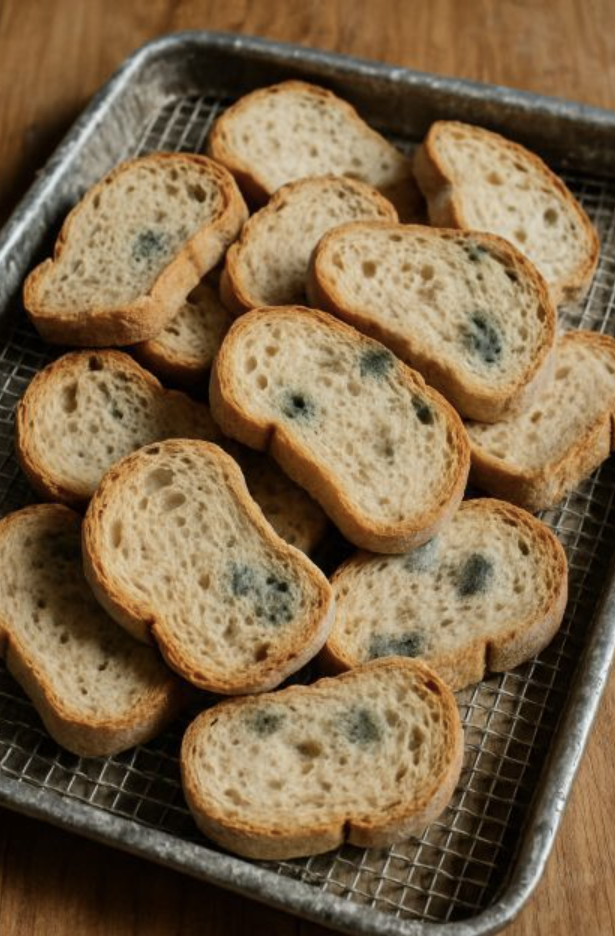The Internet’s Favorite Hacks for Stale Bread
Social media is full of clever ideas for using stale bread! One very popular hack is to make your own homemade breadcrumbs. Just grind the stale bread in a food processor, and you’ll have fresh breadcrumbs to use in recipes like meatballs or as a crispy topping for casseroles. Store them in an airtight container for future use.
Another trending idea is to turn stale bread into crispy croutons. Simply cut the bread into cubes, toss them with some olive oil and your favorite seasonings, and bake until they’re golden and crunchy. These homemade croutons are perfect for adding a delightful crunch to salads and soups.
Does Stale Bread Lose Its Goodness?
When bread goes stale, its main change is in texture, not its nutritional content. Bread is a good source of carbohydrates, fiber, and some important vitamins and minerals. These nutrients generally remain in the bread even after it becomes stale.
However, if your bread is enriched or fortified with extra nutrients, some of those might decrease over time. Also, let’s be honest, the enjoyment of eating plain stale bread might go down, which could affect how often you choose to eat it!
Keeping Bread Fresh: The Best Ways to Store It
Proper storage is super important if you want to keep your bread from going stale quickly. The best place to store bread is in a cool, dry spot, like a bread box or a paper bag that allows some air to circulate. Try to avoid storing bread in the refrigerator. The cold temperature can actually make the starch in the bread crystallize faster, leading to quicker staleness.
If you have more bread than you can eat in a few days, freezing it is a great option. Wrap the bread tightly in plastic wrap or aluminum foil, and then place it in a freezer bag. When you’re ready to use it, just let it thaw at room temperature, or you can even toast it directly from the freezer.
When to Say Goodbye: Signs Your Bread is Past Its Prime
While stale bread can often be saved, there are definitely times when it’s best to throw it out. If you see any signs of mold — like fuzzy spots or a strange, off smell — it’s time to toss that bread. Mold can spread very quickly, even if you don’t see it all over the loaf.
Also, if your bread has been sitting around for a very long time and has become extremely hard or has an unpleasant taste, it’s probably not worth trying to save. In these cases, it’s always better to put your safety and the quality of your food first.
Food Waste Around the World: Different Ways of Thinking
It’s interesting to see how different cultures view food waste. For instance, in many European countries, there’s a strong tradition of using every part of food, including stale bread, in creative ways. Think of classic dishes like Italian panzanella (a bread salad) or French pain perdu (which is simply French toast!). These are traditional recipes that cleverly use leftover bread.
On the other hand, some cultures might prefer their food perfectly fresh and might discard anything that’s no longer at its peak. Understanding these cultural differences can give us new ideas on how we approach food waste and inspire us to adopt more sustainable habits.
What the Pros Say: Chefs and Stale Bread
Many chefs don’t see stale bread as a problem, but rather as an opportunity! Top chefs often talk about how important it is to waste as little as possible and find creative uses for ingredients that might otherwise be thrown away. Stale bread can be a super versatile ingredient in the kitchen, perfect for many different dishes.
For example, Chef Massimo Bottura is famous for his dedication to reducing food waste. He has even created recipes specifically designed to use stale bread. His approach really shows how much potential there is for culinary creativity and sustainability when we think differently about food.
Making Your Choice: What to Consider
When you’re trying to decide whether to use or throw out stale bread, think about a few key things: safety, taste, and the environmental impact. If the bread is safe to eat and you can use it in a way that makes it taste good, then it’s probably worth saving. However, if the bread is moldy or just plain unappetizing, it’s best to prioritize your health and the quality of your food.
Ultimately, the choice is yours, based on your own preferences and values. By knowing all the options and the benefits of using stale bread, you can make a decision that feels right for you and helps contribute to a more sustainable lifestyle.
Do you have any favorite recipes for using up stale bread that you’d like to share?
